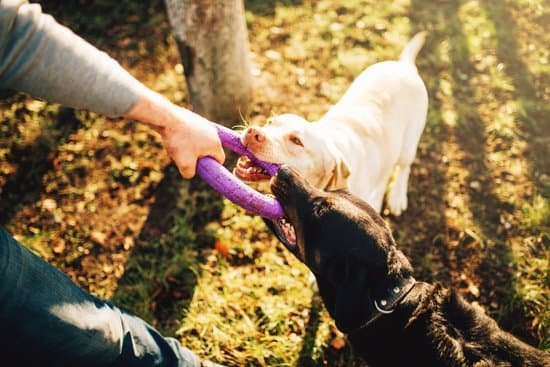Training collars can be a valuable tool when it comes to teaching your dog obedience and correcting unwanted behaviors. In this article, we will explore the basics of training collars and how they can be used effectively in dog training. Whether you are a new dog owner or have had experience with training collars before, this guide will provide you with essential information and techniques to help you train your dog successfully.
Using a training collar can make the training process more efficient and effective. It allows you to communicate with your dog through gentle corrections and reminders, helping them understand what is expected of them. However, it’s important to note that using a training collar should always be done with kindness and respect for your furry friend.
In the following sections, we will discuss the benefits of using a training collar for dog training, factors to consider when choosing the right collar for your dog, step-by-step instructions on introducing and fitting the collar properly, as well as techniques for positive reinforcement using treats and praise. We will also delve into teaching basic commands like sit, stay, and come using a training collar, as well as correcting unwanted behaviors such as jumping, barking, and leash pulling.
By the end of this article, you will have gained valuable insights into how to train your dog using a training collar effectively. We will also highlight common mistakes to avoid during the training process and explore advanced techniques that go beyond basic commands. Most importantly, we will emphasize the importance of building a lasting bond with your canine companion through positive reinforcement and consistency during training sessions.
Ready to embark on this journey towards effective dog training? Let’s dive in.
Benefits of Using a Training Collar for Dog Training
Using a training collar can provide various benefits for dog owners when it comes to training their pets. One of the main advantages of using a training collar is that it allows for effective and consistent communication between the owner and the dog. The collar serves as a tool to reinforce commands and establish boundaries, making it easier to train and control the dog’s behavior.
A training collar can also help in reinforcing positive behaviors and discouraging unwanted ones. For example, if you want your dog to learn to walk calmly on a leash without pulling, you can use a training collar to correct their behavior whenever they start pulling. This helps them understand that pulling will not be rewarded and encourages them to walk alongside you without resistance.
Another benefit of using a training collar is that it can be used as a safety measure, especially during outdoor activities or when walking in busy areas. By having control over your dog’s movements through the collar, you can prevent them from potentially dangerous situations such as running into traffic or approaching aggressive dogs.
In addition, some training collars also have features such as remote control or vibration modes, which can be helpful in certain training scenarios. The remote control allows you to give commands from a distance, while the vibration mode can be used as a gentler alternative to correction for dogs that are sensitive or fearful.
Overall, using a training collar provides dog owners with an effective tool for teaching obedience and ensuring their pet’s safety. It is important to remember that proper training techniques should always be combined with the use of the collar to achieve desired results without causing harm or distress to the dog.
| Benefits | Examples |
|---|---|
| Effective Communication | Reinforcing commands and establishing boundaries |
| Behavior Reinforcement | Dissuading unwanted behaviors and encouraging positive ones |
| Safety Measure | Preventing dangerous situations during outdoor activities or busy areas |
| Additional Features | Remote control and vibration modes for specific training needs |
Choosing the Right Training Collar for Your Dog
Consider Your Dog’s Size and Breed
When choosing a training collar for your dog, it is important to consider their size and breed. Different breeds have different temperaments and sensitivities, so it is necessary to find a collar that suits their specific needs. For example, smaller dogs may benefit from a lightweight and adjustable collar, while larger or more assertive breeds may require a sturdier collar with stronger correction settings.
Assess Your Dog’s Temperament
Understanding your dog’s temperament is crucial in selecting the right training collar. Some dogs are more sensitive and responsive to gentle stimulus, while others require stronger corrections. It is important to choose a training collar that aligns with your dog’s temperament to ensure effective training and avoid unnecessary discomfort.
Determine the Training Goals
Before purchasing a training collar, it is essential to define your training goals. Consider what behaviors you want to correct or commands you want to teach your dog. This will help determine the type of training collar that will be most effective for achieving those goals.
For example, if your main concern is leash pulling, you may opt for a no-pull harness or martingale collar. On the other hand, if you need assistance in teaching basic obedience commands, a remote controlled electronic collar may be more suitable.
Research Different Types of Training Collars
There are various types of training collars available on the market, each with its own advantages and limitations. Common options include choke collars, prong collars, vibration collars, and electronic collars. Take the time to research each type thoroughly to understand their functions and potential effects on your dog. Consider consulting with a professional dog trainer or veterinarian for recommendations based on your specific needs.
By carefully considering these factors before purchasing a training collar for your dog, you can ensure that you select the right collar that aligns with your dog’s needs, temperaments, and training goals. Remember to always prioritize your dog’s comfort and well-being and consult with professionals or experts for guidance if needed.
Step-by-Step Guide on How to Introduce and Properly Fit a Training Collar to Your Dog
Step 1: Choose the Right Training Collar for Your Dog
Before you can introduce and properly fit a training collar to your dog, it is important to choose the right collar for them. Consider factors such as the size and breed of your dog, their behavior and temperament, and any specific training goals you have in mind.
There are different types of training collars available, including flat collars, martingale collars, prong collars, and electronic collars. Research each type and consult with a professional trainer or veterinarian to determine which one would be most suitable for your dog.
Step 2: Familiarize Your Dog with the Collar
Once you have chosen a training collar, it is essential to familiarize your dog with it before attempting to use it for training purposes. Allow your dog to sniff and investigate the collar at their own pace, rewarding them with treats and praise for calm behavior. Gradually introduce the collar by placing it around their neck for short periods of time while giving positive reinforcement. This will help create a positive association between the collar and pleasant experiences.
Step 3: Properly Fit the Training Collar
Proper fitting is crucial when using a training collar on your dog. It should be snug enough to stay in place but not too tight that it causes discomfort or restricts breathing. When fitting a flat or martingale collar, ensure that you can fit two fingers comfortably between the collar and your dog’s neck.
For prong collars, make sure that the ends of the prongs are blunt and do not dig into their skin. Electronic collars should be fitted according to manufacturer instructions to ensure proper contact without causing harm.
Step 4: Gradual Introduction of Pressure
Once you have successfully fitted the training collar on your dog, it is important to introduce pressure gradually. Begin by gently applying slight pressure on the collar while giving a verbal cue or command associated with the desired behavior. As soon as your dog responds appropriately, release the pressure and reward them with treats and praise. This will help them understand that certain behaviors are rewarded while others may result in mild discomfort from the collar.
By following these step-by-step guidelines, you can introduce and properly fit a training collar to your dog in a safe and effective manner. Remember to always prioritize their comfort and well-being throughout the process. Once your dog is comfortable wearing the collar, you can move forward with using it for training purposes, which will be discussed in later sections of this article.
Positive Reinforcement Techniques
Positive reinforcement is a key aspect of effective dog training, and incorporating treats and praise can greatly enhance the learning experience for your dog. By using these techniques in conjunction with a training collar, you can build a strong foundation of positive associations with the collar and reinforce desired behaviors.
When using treats as a form of positive reinforcement, it is important to choose high-value rewards that will motivate your dog. These may include small pieces of cooked meat, cheese, or commercially available dog treats. It is also important to consider the size and breed of your dog when selecting treats, as larger dogs may require bigger rewards to be effective.
In addition to treats, praise is another powerful tool for reinforcing desired behaviors. Dogs thrive on attention from their owners, so verbal cues such as “good job” or “well done” can go a long way in encouraging them. Physical affection like petting or a belly rub can also be used as praise during training sessions.
To effectively incorporate treats and praise into your training sessions, it is important to follow certain guidelines. Firstly, timing is crucial – rewards should be given immediately after the desired behavior occurs to ensure that the association between the behavior and the reward is clear. Consistency is also key – use treats and praise consistently each time the desired behavior is displayed. This helps reinforce the connection between the behavior and the positive outcome.
Overall, incorporating treats and praise into your training sessions can greatly enhance your dog’s motivation and learning experience. By using these positive reinforcement techniques in conjunction with a training collar, you can create a rewarding and enjoyable training journey for both you and your furry companion.
| Treats | Praise |
|---|---|
| High-value rewards (cooked meat, cheese, etc.) | Verbal cues (“good job,” “well done”) |
| Consider size and breed of dog when selecting treats | Physical affection (petting, belly rubs) |
| Timing is crucial – reward immediately after desired behavior | Use treats and praise consistently |
Teaching Basic Commands Using a Training Collar
Training a dog to understand and follow basic commands is an essential part of their behavioral development. With the use of a training collar, teaching these commands becomes even more efficient and effective. The three basic commands that every dog should know are sit, stay, and come.
Sit
To teach your dog how to sit using a training collar, follow these steps:
- Hold the training collar in one hand while standing in front of your dog.
- Give the verbal command “sit” while gently pushing down on your dog’s hindquarters using your other hand.
- As soon as your dog sits, provide immediate positive reinforcement such as giving a treat or praise.
- Repeat this process several times until your dog starts associating the command with sitting.
- Gradually reduce the physical guidance from your hand and rely solely on the verbal command and signal from the training collar.
Stay
Here’s how you can train your dog to stay using a training collar:
- Attach a leash to the training collar and keep it short enough for control.
- Ask your dog to sit or lie down.
- Once they are in position, slowly back away while maintaining eye contact.
- If your dog tries to follow you, gently tug the leash and give them the verbal command “stay.”
- Return to your original position and reward your dog with praise or treats if they remain in place.
- Gradually increase the distance and duration of the stay command over time, always rewarding successful compliance.
Come
Teaching your dog to come when called is crucial for their safety and well-being. Here’s how you can use a training collar to train this command:
- Start by attaching a long leash to their training collar for added control during initial stages of training.
- Get down on their level and use an excited and inviting tone to call their name, followed by the command “come.”
- Gently reel in the leash if your dog doesn’t respond immediately.
- When your dog comes to you, provide positive reinforcement in the form of treats or praise.
- Practice this command in different environments and gradually decrease reliance on the leash, ensuring your dog comes whenever called.
Remember, consistency is key when training your dog using a training collar. Practice these basic commands regularly and always reward positive behavior to ensure a strong foundation for further training.
Correcting Unwanted Behavior
One of the primary advantages of using a training collar is its effectiveness in correcting unwanted behaviors in dogs. If your dog tends to jump on people, bark excessively, or pull on the leash during walks, a training collar can be a valuable tool to address these issues. Here’s how you can use a training collar to correct these unwanted behaviors:
- Jumping: When your dog jumps on people, it can be both dangerous and annoying. To discourage this behavior, start by instructing your dog to sit or stay.
When your dog starts jumping, issue a firm “no” command and simultaneously press the remote button to deliver a gentle but noticeable stimulation with the training collar. With consistent corrections and positive reinforcement when your dog remains calm and doesn’t jump, they will learn that jumping results in an unpleasant experience. - Barking: Excessive barking can be disruptive and stressful for both you and your neighbors. To address this behavior with a training collar, pay attention to the triggers that cause your dog to bark unnecessarily. Once you identify these triggers (such as strangers approaching the house or other dogs passing by during walks), use the remote control to deliver a mild stimulation when your dog starts barking without reason.
It’s crucial always to pair this correction with verbal cues like “quiet” or “enough.” Over time, your dog will associate the stimulation with stopping barking and respond accordingly. - Leash pulling: Many dogs tend to pull on leashes during walks due to their excitement or desire to explore their surroundings. A training collar can help discourage leash pulling by providing gentle feedback when your dog pulls too hard. Attach the leash to both the training collar and a regular harness or flat collar for added safety.
As soon as your dog starts pulling, issue a “heel” or “let’s go” command while applying a mild stimulation through the training collar. When your dog walks calmly by your side without pulling, reward them with praise and treats to reinforce the desired behavior.
Remember, when using a training collar to correct unwanted behaviors, it’s crucial to be consistent and patient. Every dog is different, and it may take some time for them to understand and respond to the corrections.
Always make sure you are using the training collar properly and start with low levels of stimulation, gradually increasing if necessary. With consistency and positive reinforcement, you can effectively address jumping, barking, and leash pulling with a training collar while strengthening your bond with your furry companion.
Consistency and Patience
Understanding the Importance of Consistency
Consistency is key when it comes to training a dog with a training collar. Dogs thrive on routine and become more confident and responsive when they know what is expected of them. Therefore, it is essential for dog owners to establish consistent rules and expectations throughout the training process.
First and foremost, consistency in commands is crucial. Ensure that everyone who interacts with your dog uses the same commands for basic obedience cues such as “sit,” “stay,” and “come.” This will prevent confusion for your dog and make it easier for them to understand and respond to your instructions.
Consistency also extends to your use of the training collar. Make sure you are using the collar in the same manner each time you engage in a training session. Use the same level of correction or stimulation consistently so that your dog can learn to associate their actions with specific consequences.
The Power of Patience
Patience plays an integral role in building a strong foundation in training with a training collar. Remember that every dog learns at their own pace, and it may take some time for them to fully understand what is expected of them.
When introducing a new command or correcting unwanted behavior, be patient with your dog’s progress. It is important not to rush or become frustrated if they do not immediately grasp what you are trying to teach them. Stay calm, provide clear instructions, and give your dog enough time to process the information.
Additionally, practicing patience involves rewarding even small improvements or steps towards desired behavior. Instead of expecting perfection right away, acknowledge and reinforce any effort or progress made by your dog. This positive reinforcement will motivate them to continue putting in the effort during future training sessions.
Troubleshooting Challenges Along the Way
During the training process, it is common to encounter challenges or setbacks with your dog’s behavior. If you find yourself facing difficulties, it is crucial to approach them with a patient and consistent mindset.
One common challenge is when your dog becomes desensitized to the training collar. If you notice that the collar’s correction is no longer effective, it may be helpful to take a step back and reassess your training methods. Gradually increase the stimulation level or consider seeking guidance from a professional dog trainer to ensure you are using the collar correctly.
Another challenge may arise if your dog starts exhibiting fear or anxiety in response to the training collar. In this case, pause the use of the collar and focus on building positive associations. Gradually reintroduce the collar in a non-threatening manner, using plenty of treats and praise to create a more positive experience for your dog.
Common Mistakes to Avoid When Training a Dog with a Training Collar
When training a dog with a training collar, it is important to be aware of the common mistakes that dog owners often make. By avoiding these errors, you can ensure that your training sessions are productive and effective. Here are some common mistakes to avoid when using a training collar:
Improper fit
One of the most common mistakes dog owners make is not fitting the training collar properly on their dogs. It is essential to ensure that the collar is snug but not too tight around the dog’s neck.
If the collar is too loose, it may not provide effective correction, and if it is too tight, it can cause discomfort or injury. Before using the training collar, carefully read the instructions on how to fit it correctly and adjust it accordingly.
Inconsistent use
Consistency is vital in dog training, especially when using a training collar. Inconsistent use of the collar can confuse your dog and hinder their progress in learning new behaviors or correcting unwanted ones. Set a regular schedule for training sessions and follow through with them consistently. Ensure that all family members involved in your dog’s training are on the same page and use the same commands and techniques.
Over-correction
Another mistake to avoid when using a training collar is over-correcting your dog. While correction is an important part of behavior modification, excessive or unnecessary corrections can lead to fear or anxiety in your dog. Pay attention to your dog’s body language and reactions during training sessions, and adjust the level of correction accordingly. The goal should be to guide your dog towards desired behaviors rather than instilling fear or discomfort.
By being mindful of these common mistakes, you can effectively train your dog using a training collar while maintaining a positive and respectful relationship with them. Remember that patience, consistency, and clear communication are key ingredients for successful training sessions with a training collar.
Advanced Training Techniques
Once your dog has mastered basic commands and you have successfully corrected unwanted behaviors using a training collar, it’s time to progress to advanced training techniques. This will not only challenge your dog mentally and physically but also strengthen the bond between the two of you. Here are some advanced techniques you can try with your dog using a training collar.
- Agility Training: Agility training is an excellent way to engage your dog both mentally and physically. Set up an agility course in your backyard or find a local agility class where you can practice together. Incorporate the use of a training collar to teach your dog to navigate through obstacles such as tunnels, jumps, and weave poles. The training collar can be used to reinforce commands like “over,” “through,” or “weave” during the training process.
- Off-Leash Recall: Teaching your dog reliable off-leash recall is essential for their safety and freedom. Start by practicing in an enclosed space such as a fenced-in yard or a quiet park with no distractions. Use the training collar in conjunction with positive reinforcement techniques to reinforce the command “come.” Gradually increase the level of distractions as your dog becomes more proficient in responding to the command.
- Scent Detection: Dogs have an amazing sense of smell, making them perfect candidates for scent detection work. Whether it’s searching for hidden treats or participating in nosework classes, scent detection provides mental stimulation and builds confidence in your dog. Use the training collar to guide your dog during searches and reward them when they locate the target scent.
Remember, advanced training techniques require patience and consistency just like basic commands and behavior correction exercises. Always ensure that you are using positive reinforcement combined with the proper use of a training collar to communicate effectively with your dog throughout these advanced sessions.
By incorporating these advanced techniques into your training routine, you can continue challenging and stimulating your dog’s mind while achieving new levels of obedience and responsiveness. Moreover, it will create a sense of accomplishment for both you and your furry friend, helping to solidify the bond between you.
Building a Lasting Bond
Training a dog using a training collar not only helps in teaching them obedience and correcting unwanted behavior, but it also plays a significant role in strengthening the bond between dog and owner. The sessions with the training collar create an opportunity for effective communication and reinforce trust and respect between the two.
One of the key ways that training collar sessions can strengthen your relationship with your dog is by establishing clear boundaries and expectations. By consistently using the training collar to teach commands and correct behavior, you are setting clear guidelines for your dog to follow. This clarity helps them understand what is expected of them, which promotes a sense of security, confidence, and overall well-being.
Another way that training collar sessions can enhance your relationship with your dog is through positive reinforcement. Positive reinforcement involves rewarding your dog for desired behaviors with treats or praise. When using a training collar, you can combine positive reinforcement techniques with commands to further motivate your dog to obey and engage in proper behavior. This positive association between rewards and good behavior deepens their trust in you as their handler.
Furthermore, training collar sessions provide an opportunity for quality bonding time with your canine companion. Through consistent training sessions, you will spend dedicated one-on-one time together, building trust, understanding, and respect. Over time, these interactions contribute to a stronger emotional connection between you and your dog. The more time you invest in working together towards common goals during training sessions, the more solidified your bond becomes.
To summarize, using a training collar effectively can help build a lasting bond between you and your furry friend. It establishes clear boundaries that promote security and confidence for your dog while also incorporating positive reinforcement techniques that strengthen trust and motivate obedience. Additionally, consistent training sessions provide valuable bonding opportunities that deepen the emotional connection between you both. Investing time in utilizing a training collar can ultimately result in a stronger relationship and a happier, well-behaved dog.
| Benefits | Data |
|---|---|
| Promotes clear boundaries and expectations | Establishes security, confidence, and well-being for the dog |
| Incorporates positive reinforcement techniques | Strengthens trust and motivates obedience |
| Provides quality bonding time | Deepens emotional connection between dog and owner |
Conclusion
In conclusion, the use of training collars can be an effective tool in training and disciplining your dog. By understanding the basics of training collars and considering essential factors such as size, material, and functionality when choosing the right collar for your dog, you can ensure a comfortable and safe fit.
Positive reinforcement techniques, such as incorporating treats and praise, can enhance the effectiveness of using a training collar. It is important to remember that consistency and patience are key when building a strong foundation in training. By consistently enforcing basic commands and addressing unwanted behaviors with the training collar, you can help your dog develop good manners and become a well-behaved companion.
While using a training collar can be beneficial, it is important to avoid common mistakes such as using excessive force or relying solely on the collar without providing proper guidance and instruction to your dog. Additionally, advanced training techniques beyond basic commands can further strengthen the bond between you and your dog.
By following these effective training collar techniques, you have the opportunity to empower yourself as a dog owner. Training collars offer an effective way to communicate with your dog and create a harmonious relationship based on mutual understanding and respect. With time, patience, and consistent efforts in applying these techniques, you can help your furry friend become a well-trained and obedient member of your family.
Frequently Asked Questions
How do you use a dog training collar effectively?
Using a dog training collar effectively requires understanding its purpose and using it responsibly. Firstly, it is crucial to choose an appropriate collar size that fits comfortably on the dog’s neck. It should fit snugly without causing any harm or discomfort. Before putting the collar on, ensure that your dog is calm and relaxed to create positive associations with wearing it.
When using the training collar, consistency and timing are key factors. Use clear verbal cues or hand signals along with the collar’s correctional feature to teach your dog specific commands or behavior modifications. It’s important to remember that a training collar should never be used as a substitute for proper training techniques such as positive reinforcement and rewards.
How do you train a dog to use a shock collar?
Training a dog to use a shock collar should be approached with caution and only by individuals who have extensive knowledge of dog behavior and training techniques. Before introducing a shock collar, it is crucial to have established basic obedience training using positive reinforcement methods. The shock collar should never be used as a punishment tool but rather as an aid in reinforcing known commands or modifying unwanted behaviors in specific situations where other training methods may not be effective.
Slowly introduce the shock feature at low levels and monitor your dog’s response closely to ensure they are not experiencing unnecessary discomfort or fear. Consistency, gradual progression, and always rewarding good behavior alongside the use of a shock collar will help promote effective training.
Is it better to train a dog with a collar or harness?
The decision between using a collar or harness for dog training depends on various factors such as the individual dog’s breed, size, temperament, and specific needs during different activities like walking or obedience training. Both collars and harnesses have their advantages and disadvantages. Regular collars can be beneficial for dogs already familiar with leash manners while providing quick control during walks; however, they can put strain on the neck if the dog pulls excessively.
Harnesses distribute pressure more evenly across the chest and shoulders, making them suitable for dogs prone to respiratory issues or those who pull on the leash. Harnesses can also be useful during training sessions that focus on loose-leash walking or teaching dogs not to pull. Ultimately, it’s important to consider your dog’s comfort, safety, and individual needs when choosing between a collar or harness for training purposes.

Welcome to the blog! I am a professional dog trainer and have been working with dogs for many years. In this blog, I will be discussing various topics related to dog training, including tips, tricks, and advice. I hope you find this information helpful and informative. Thanks for reading!





